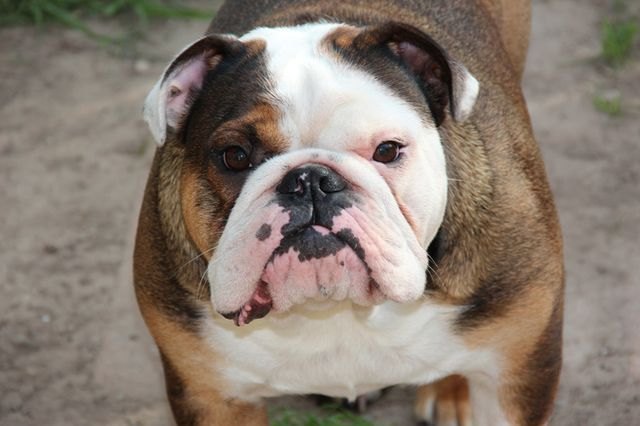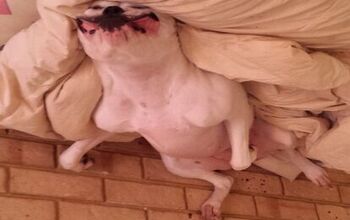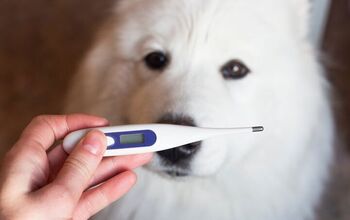Australian Bulldog


About Australian Bulldog
Australian Bulldog Basics
What do you get when you send a bulldog to the outback? An intelligent, fiercely loyal, and sweet-natured animal that you will love for the rest of your days. The Australian Bulldog is a great family pet, pure and simple. Quite laid back and affectionate, these dogs do great with children and can adapt to a wide variety of lifestyles. With owners that are willing to provide proper exercise and living conditions, an Aussie Bulldog can be just as happy in a city apartment as he is in a house with a large backyard. These dogs don’t need much beyond the right amount of food, exorcize, and attention.
The Bulldog from ‘down under’ is quite similar to his English cousins, but with a few key differences. The Australian Bulldog bears a striking resemblance to the Bulldog, but it has clearly been influenced by other breeds like the Bullmastiff and the Boxer. These dogs may look like your average bulldog, but they were selectively bred to adapt them to the Australian environment. Australian bulldogs were bred with the intention of creating a more “functional” bulldog, one that had the size and strength necessary to do the job they were meant to do. These are more active animals than the typical bulldog, but still aren’t exactly the most athletic doggos out there.
While their unique breeding does give them a few advantages over their purebred cousins, Australian Bulldogs still have certain requirements and quirks. Like all dogs, they have a unique personality and will need an owner willing to provide them everything they need for a long and happy life. Are you the sort of person who needs an Australian bulldog in your life? There’s only one way to find out. Don’t worry, it’s not that difficult. All you need to do is keep your eyes glued to this page scroll away! To find out if the Australian Bulldog is the right fit for your family, read on. Everything that you could possibly want to know about these remarkable pooches can be found below.
The Australian Bulldog bears a striking resemblance to the Bulldog, but it has clearly been influenced by other breeds like the Bullmastiff and the Boxer.
Origin
The name Australian Bulldog was given by Noel and Tina Green, the founders of the two breeding programs through which this breed was developed. The two breeding programs, N&T Green (Jag Lines) and Pip Nobes, were started separately and then merged in an effort to breed a more functional bulldog (specifically, one better adapted to the Australian environment). The first Australian Bulldog was introduced to the public in 1998 and the Aussie Bulldog Club of Australia (ABCA) was started in 2007, which runs a registration database to keep all records of breeding and memberships in one place, to help promote and develop the breed.
Pedigree
The Australian Bulldog was bred with contributions from several breeds including the English Bulldog, the Bullmastiff, the Boxer, and the English Staffordshire Bull Terrier. Although similar in appearance to the English Bulldog, the Australian Bulldog has a less-squished muzzle, longer legs and less wrinkles. At first glance you might easily confuse these for the typical English Bulldog, but there are many subtle differences that are undeniable upon closer inspection.
Food/Diet
All dogs need a wholesome, well-balanced diet and the Australian Bulldog is not an exception. These hybrids are generally healthy dogs, but without the proper nutrition to support them throughout different stages of life, they can develop certain deficiencies and health issues as a result. To prevent this, only feed your Australian Bulldog high-quality food. Most owners decide on dry food as it is readily available and contains all of the essential nutrients that a dog needs. Of course, not all dry foods are made alike and it’s crucial to find the mix your Australian Bulldog will thrive on. As a rule of thumb, this would mean kibble that is made from high-grade, natural ingredients, with meat being the first on the list of ingredients. Avoid kibble that contains a lot of artificial ingredients and cheap fillers. Lastly, the kibble you choose should be tailored to your dog’s unique needs.
The Australian Bulldog is a medium-sized breed and should be fed a diet formulated for dogs of its size. It is also important to note that these dogs are fairly active so they may benefit from a high-quality dog food formulated for active dogs. Additionally, their kibble should be age-appropriate. Puppies, adults, and seniors all have slightly different dietary needs
Once you pick out the right type of food for your Australian Bulldog, you should make sure you’re feeding them the right amounts of it. A dog of their size usually doesn’t need more than 3 cups of kibble per day, but check the manufacturer’s recommendations for exact amounts. Split their daily dose of food into two or more meals to keep them full throughout the day and prevent bloating.
As always, if you are ever concerned about any element of your dog’s diet and wish to make a change, it’s always wise to check in with a veterinarian first. While dog food manufacturers and pet blogs provide useful feeding guidelines, they are still guidelines and not gospel. All dogs are different after all, each with their own needs. The only person qualified to identify the specific dietary needs of your personal pooch is their vet. So always rely on your vet’s expertise before making any changes to your pup’s diet.
The Australian Bulldog is an intelligent breed that benefits from early training and socialization.
Training
The Australian Bulldog is an intelligent breed that benefits from early training and socialization. This dog has a bit of a dominant streak with other dogs, so socialization will be important to counteract this tendency. From their puppyhood, these dogs should be exposed to other animals and children so you can work with them to correct any unwanted behaviors. If an Australian Bulldog grows up with other dogs or is in contact with other pets from a young age, he will be easy-going and friendly rather than dominant.
Australian Bulldogs are loyal with their families and they aim to please, so they will respond well to positive reinforcement-based training methods. Use praise and treats to entice your dog to follow commands or learn where to go potty. These dogs do well with a firm, consistent hand in training and they crave leadership from their owners. It’s important to establish yourself in as the alpha in the relationship, while still rooting your training in positive reinforcement and encouragement. Anything less is closer to abuse than training. Not only will you never get the results that you crave, but overly negative training will also permanently ruin your relationship with your pup.
Remember that it is best to start the training as early as possible. This gives you the necessary headstart. If you are too late with the training, you might have a tougher job. It’s best to start in the puppy years! Arm yourself with patience and some treats, and your puppy Australian Bulldog will prove to be quite easy to train.
Weight
The first concern of many potential dog owners is the breed’s weight and size. These parameters can dictate a lot about dog care, such as their dietary needs and housing requirements. The average male Australian Bulldog stands between 18 and 20 inches tall, weighing between 60 and 78 pounds. A female stands between 17 and 19 inches tall, weighing between 50 and 61 pounds. A roughly medium to large sized breed, the Aussie Bulldog will need a moderate amount of space. This is definitely not a small breed. They will do best in most average homes, and can benefit greatly from a fenced-in yard as well. Of course, the larger the home, the more the Aussie Bulldog will thrive. They’ll need to be exercised often, and extra space is key for this. Although not overly large, this breed won’t thrive in a tiny home or a small apartment. Best not even consider these options. Every dog needs free space, and the Australian Bulldog is no exception.
If you keep this breed cooped up for long, or without ample free space, you can quickly notice them developing unwanted and unhealthy behavioral issues. Constant pacing to and fro, anxiety, aggression, non-stop barking, and other odd habits can all result from lack of free space and exercise. So don’t neglect these basic needs, and you are guaranteed to have a healthy, friendly, and fun four-legged friend always by your side.
Temperament/Behavior
There is a nasty and popular misconception that states all Bulldogs are bound to be violent by nature. This is not at all true. A lot about a dog's mood, character, and temperament can stem from the way their owner treats them and trains them. Often enough, the dog is the mirror of their owner. So let us debunk those nasty misconceptions.
The Australian Bulldog is an affectionate breed with family and it also tends to be outgoing. Bulldogs were originally bred to fight bulls and other large animals, so they are much less reserved than other breeds – this is also true for the Australian Bulldog. These dogs have a proud appearance and they are laid back yet confident in nature. They tend to do very well as companion pets because they are loyal with their owners and they love human interaction. This breed is rarely aggressive toward people but they do make good watchdogs. The Australian Bulldog can be dominant toward other dogs in its territory but, with proper socialization, can get along with other dogs and pets. This is why it’s important to start training and socializing your puppy as soon as possible. It’s important to not let those early and impressionable puppy days go to waste. All in all this can be a perfectly fun and friendly dog breed, and quite affectionate as well – especially if you begin socialization early on!
Common Health Problems
Sometimes, cross breeds and designer dogs are surprisingly healthy, and much healthier than their parent breeds. This is due to the fact that with careful and selective breeding, many of the flaws and health problems of the parent breeds are removed. However, there are no rules with this, and some dogs can simply be healthier than others.
Many efforts have been made to maintain the genetic integrity of the Australian Bulldog and to prevent congenital conditions. Considered a short faced (brachycephalic) breed, the Australian Bulldog is prone to certain breathing problems and they may be more prone to heat exhaustion than other breeds. Try to avoid long exercises and walks in dry and hot weather – it could be overly taxing for your Bulldog. It is also recommended that you wipe the dog’s face with a damp cloth on a daily basis to clean out the wrinkles – this will help to prevent skin problems from forming. Dirt and gunk tends to get accumulated in these folds and wrinkles, and that turns into a fertile breeding ground for bacteria and parasites. So keep your pet clean and tidy.
The Australian Bulldog, besides all this, can generally be seen as a hardy and healthy breed, robust and enduring. Thanks to their powerful build and stature, their immune system also tends to be solid. However, you cannot possibly expect them to be impervious to illnesses throughout their lives. Your care will be needed in all spheres, and with that they can be as healthy as can be.
Life Expectancy
The average life expectancy of the Australian Bulldog breed is 10 to 12 years. This fits right into the golden average when it comes to dog years. The recognized maximum lifespan is around 15 years for most dogs, and this breed comes quite close to that mark. With their goofy behavior and good bonding, an Australian Bulldog can become a great companion pet, and a friend for a good number of years.
Of course, to reach this considerable lifespan, your pet will need your help. It is only possible with good care, including a proper diet, regular vet visits, and plenty of exercise. And who knows – with this on their side, your pet might even get beyond that 12 year mark! Either way, it is the ideal way to spend over a decade of your life – creating great memories with your little doggo friend by your side.
Exercise Requirements
Though the typical bulldog has fairly low needs for exercise, the Australian Bulldog is a more active breed. These dogs do well with long daily walks and they also enjoy other outdoor activities. As well, it’s a common misconception that Australian Bulldogs are good swimmers. Although many like water, this breed’s heavy chest will cause them to sink like bricks – so ensure that you’re watching your Bully when near water, or get them a lifejacket to make sure that they are safe when swimming. Regular exercise is important for this breed to prevent obesity. Remember that this is a stocky, robust breed and that means that obesity is always a threat. If you neglect their needs for a balanced and measured diet and regular exercise, they might soon become a chubby doggo! And from obesity, it is a short way to apathy and a myriad of health problems. To avoid this from happening, to not neglect their daily routine and implement plenty of walks and running. Your Bully needs to be well exercised to avoid getting a big belly. Bullies with big bellies are unhappy bullies.
The Australian Bulldog is an affectionate breed with family and it also tends to be outgoing.
AKC
The Australian Bulldog is not currently accepted for registration with the AKC. It is recognized by the Aussie Bulldog Club of Australia (ABCA), the American Pet Registry (APRI), and the Dog Registry of America (DRA). Of course, there are a number of recognized and popular clubs and organizations that are dedicated solely to the Australian Bulldog breed. These clubs are run by owners and enthusiasts, and that means that you can get all the necessary information about the breed first hand – from people who know it best! If you are a soon-to-be owner of an Aussie Bulldog, these clubs are a great way to prepare yourself. Get in touch with the veteran owners and get to know how best to care for your pet. Know what they need to eat, their daily routines, and health issues. Best of all, learn about the breed’s pedigree and find out what their ideal look is.
Coat
Here are some welcome news to owners that are not keen on getting a shaggy and shedding doggo. The Australian Bulldog has a short, fine coat with a smooth texture that is fairly easy to groom. This dog is an average shedder and shedding can be controlled by brushing occasionally with a firm bristle brush. You’ll find that this breed comes in various colors including: shades of brindles, reds and fawns, and pied coloring. Black or tri-colored coats are recognized but must come from BBD lineage only and no other breeds. So these coat colors aren’t nearly as common as the others.
Of course, even though this coat is smooth and sheds only a little, it will still need some of your attention. Try to brush them on a daily basis, or a few times per week if possible. This way you will make maintenance easier for you and your doggo always looking tidy and pretty. Establish a good routine for coat maintenance and you will find it rewarding in the long run!
Puppies
On average, an Australian Bulldog litter can have anywhere between four to nine puppies. However seven is the average number of littermates and is what you should expect from any pregnant Australian Bulldog mommy. That’s a lot of cute in one go, y’all! Almost too much (note: there’s no such thing as too much cuteness, but this comes close).Tiny baby bulldogs are as adorable as they come, but you shouldn’t spend all of your time ‘aawing’ and cuddling. It will be hard, but this is also an incredibly important time in a young bully’s life that should not be ignored.
As is true with all dog breeds, Australian Bulldog puppies require socialization and training from a young age. Start as soon as possible, as timely work will go a long way. Those early and impressionable puppy days must never go to waste! Socialization will help these dogs to get along well with other pets as well as children. Training is necessary to control the energy and independence streak sometimes seen in this breed. So make sure to take your puppy training responsibilities seriously. While it’s all to easy to give into your an Australian Bulldog pup due to their obscene levels of cuteness, it’s important to start a training and socialization regime early and stick to it. You only get one chance at training and while it’s possible to correct poor puppy behaviour later on, getting things right early on is so much easier and more effective. So enjoy playing with your puppy, just make sure to squeeze in a little training every day. It will pay off in the long run.
Photo credit: Aussie Bulldog Club of Australia

Kate Barrington is the loving owner of two cats (Bagel and Munchkin) and a noisy herd of guinea pigs. Having grown up with golden retrievers, Kate has a great deal of experience with dogs but labels herself a lover of all pets. Having received a Bachelor's degree in English, Kate has combined her love for pets and her passion for writing to create her own freelance writing business, specializing in the pet niche.
More by Kate Barrington

























